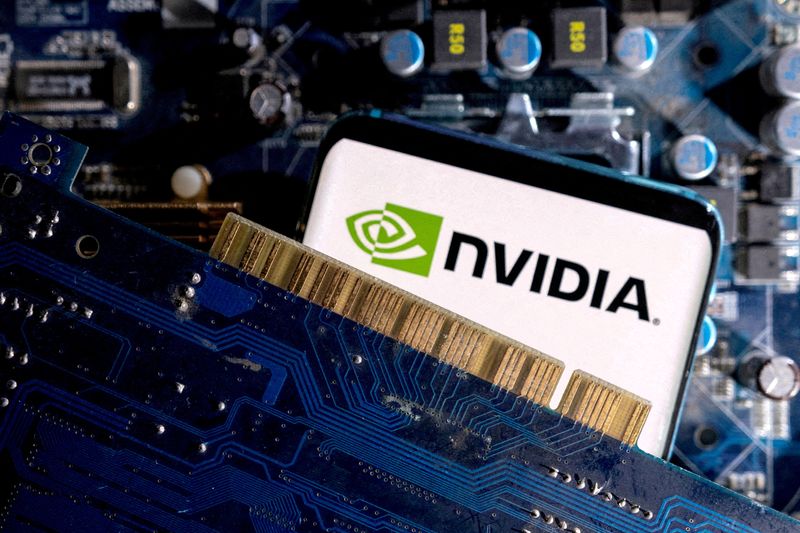A look at the day ahead in U.S. and global markets from Mike Dolan
After all that, Nvidia (NASDAQ:NVDA) beat expectations – which has become “expected” – and the stock retreated about 5%. This is still August, after all.
To be fair, the negative market reception to the artificial intelligence pacesetter’s quarterly results overnight was typical of the reaction to other ostensible “beats” in the sector in this earnings season. These stocks are expensive, have come a long way in a short space of time and the bar to impress is now sky high.
And while the hoopla around the $3.1 trillion-valued Nvidia’s earnings this week reflects long-standing concerns about over-concentration of the market on the fortunes of a handful of companies, the wider disturbance has been limited.
There were some clouds on the horizon of the megacap chip designer, but the main concern was simply that the “beat” wasn’t as big as it has been recently. For all the reasonable concerns, this was far from a fatal blow to the AI theme.
Spin out to other related readouts and the sky still looks pretty clear. Salesforce (NYSE:CRM) beat Wall Street expectations on revenue and profit too amid higher spending on its enterprise cloud products – sending its shares up 3% in extended trading.
Super Micro Computer (NASDAQ:SMCI) did tumble almost 20% on Wednesday – but that was after the AI server maker said it would delay the filing of its annual report a day after Hindenburg Research disclosed a short position in the company.
And away from the Big Tech and AI world, the market value of billionaire Warren Buffett’s Berkshire Hathaway (NYSE:BRKa) surpassed $1 trillion for the first time with a modest 1% gain in its class B stocks.
The upshot ahead of Thursday’s bell? U.S. stock futures were steady to higher after the indexes ebbed marginally in the previous session.
ATTENTION BACK ON MACRO WORLD
Attention now switches back to the macro world, with the significant backdrop of a likely first Federal Reserve rate cut in the cycle next month.
Even hawkish Atlanta Fed boss Raphael Bostic said overnight that it may be “time to move”, even though he retained the right to see some more data before making up his mind.
On that score the next ingredients come later today with another critical health check on the labor market and weekly jobless claims, with the Fed’s favored PCE inflation gauge due out tomorrow.
A punchy 100 basis points of Fed easing is still priced into the futures market by year-end – so perhaps there’s some room to row that back, regardless of thinking on the first move in September.
Despite a heavy week of Treasury debt sales, that Fed picture remains a balm for the bond market. Two-year yields recorded their lowest New York close in more than a year on Wednesday and remained subdued at 3.86% first thing today, and 10-year yields slipped back too.
The global inflation picture still appears benign.
Oil prices remain under wraps even against unsettling supply threats and continue to register year-on-year losses of up to 7%. U.S. retail gasoline prices are down more than 14% on this time last year, the deepest annual loss in 12 months.
Inflation fell in six important German states in August due to lower energy prices, suggesting Germany’s national inflation rate could decline noticeably this month.
Economists polled by Reuters forecast a harmonised national inflation rate in Germany – the euro zone’s largest economy – of 2.3% in August, down from 2.6% the previous month. But the readout from the states means than could now come in even lower.
With markets already pricing a second interest rate cut this year from the European Central Bank even before the Fed meets next month, the euro fell back sharply on Thursday and lifted the dollar index more broadly.
Just as important, money markets now see a 70% chance of third ECB cut in October.
And in China, the offshore yuan surged to its strongest level in more than three weeks despite mainland stocks there ending in the red again.
UBS on Wednesday cut its 2024 economic growth forecast for China to 4.6% from 4.9%, as it expects weaker property activity to have bigger than previously assumed drag on the overall economy.
But in some sign of detente between the world’s two biggest economic powers, U.S. National Security Adviser Jake Sullivan met Chinese President Xi Jinping in Beijing on Thursday and wrapped up three days of wide-ranging talks aimed at easing tensions between the two ahead of November’s U.S. election.
Key developments that should provide more direction to U.S. markets later on Thursday:
* US Q2 GDP revision, weekly jobless claims, July trade balance, July wholesale/retail inventories, July pending home sales; Canada Q2 current account
* Atlanta Fed President Raphael Bostic speaks
* US corporate earnings: Best Buy (NYSE:BBY), Dollar General (NYSE:DG), Ulta Beauty (NASDAQ:ULTA), Lululemon (NASDAQ:LULU), Athletica, Autodesk (NASDAQ:ADSK), Campbell Soup (NYSE:CPB), Brown-Forman, MongoDB (NASDAQ:MDB)
* US Treasury sells $44 billion of 7-year notes, $85 billion of 4-week bills, $80 billion of 8-week bills
(By Mike Dolan, editing by XXXX; mike.dolan@thomsonreuters.com)

